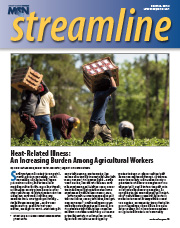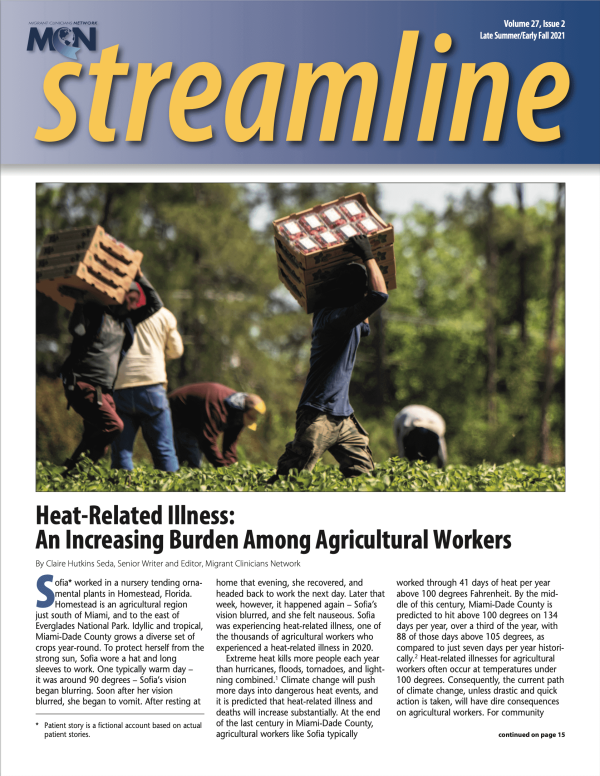
Sofia* worked in a nursery tending ornamental plants in Homestead, Florida. Homestead is an agricultural region just south of Miami, and to the east of Everglades National Park. Idyllic and tropical, Miami-Dade County grows a diverse set of crops year-round. To protect herself from the strong sun, Sofia wore a hat and long sleeves to work. One typically warm day – it was around 90 degrees – Sofia’s vision began blurring. Soon after her vision blurred, she began to vomit. After resting at home that evening, she recovered, and headed back to work the next day. Later that week, however, it happened again – Sofia’s vision blurred, and she felt nauseous. Sofia was experiencing heat-related illness, one of the thousands of agricultural workers who experienced a heat-related illness in 2020.
Extreme heat kills more people each year than hurricanes, floods, tornadoes, and lightning combined.1 Climate change will push more days into dangerous heat events, and it is predicted that heat-related illness and deaths will increase substantially. At the end of the last century in Miami-Dade County, agricultural workers like Sofia typically worked through 41 days of heat per year above 100 degrees Fahrenheit. By the middle of this century, Miami-Dade County is predicted to hit above 100 degrees on 134 days per year, over a third of the year, with 88 of those days above 105 degrees, as compared to just seven days per year historically.2 Heat-related illnesses for agricultural workers often occur at temperatures under 100 degrees. Consequently, the current path of climate change, unless drastic and quick action is taken, will have dire consequences on agricultural workers. For community health workers and outreach workers, heat-related illnesses are not only critical to address but necessitate a greater focus so that agricultural workers are aware of the increasing risk due to the climate crisis.
Who are the most vulnerable to heat-related illness?
• Those who work outside, including agricultural workers and construction workers, and those who work in warehouses or other indoor locations without ventilation or climate controls, like restaurant workers, warehouse workers, and meat packers;
• Those from lower socio-economic status;
• Those with chronic illnesses;
• Those on certain medications or drugs;
• Migrants;
• Pregnant women;
• Children.
Heat-related illness occurs when a body’s internal temperature has increased and is unable to cool itself. As the heat of the body increases, the severity of the heat-related illness grows. There are several types of heat-related illnesses:
- Heat rash, cramps, or fatigue: These health concerns typically occur in warm or hot weather but when the body is not at a dangerous heat level. Similar symptoms like rash and cramping may occur with simple exertion on the job. Pain in the stomach, legs, or arms is also common. Heat rash, cramps, and fatigue are warning signs of the body. Workers are recommended to rest in the shade to avoid advancement into more serious states of heat-related illness.
- Heat exhaustion: While the skin may remain cool and moist from sweat, the body temperature is rising to more dangerous levels when a worker experiences heat exhaustion. Heavy sweating, headache, nausea or vomiting, dizziness, light-headedness, weakness, increasing thirst, and a faster heartbeat are common symptoms. Again, the body is pushing the worker to stop and rest, to get the body temperature down before it advances into heat stroke.
- Heat stroke: Internal temperature is at 104 degrees Fahrenheit or higher. At this temperature, workers often experience confusion or delirium. Workers often stop sweating when experiencing heat stroke. Seizures, unconsciousness, and death may occur. Heat stroke is deadly and constitutes a medical emergency.
Key factors to avoid heat-related illness at each of its levels include hydration, shade, and rest. Hydration is particularly critical for agricultural workers. A 2017 study indicated that many agricultural workers arrive at work already dehydrated, increasing their risk of heat-related injury at work.3 Further, without a federal heat standard, employers may not be providing sufficient water, shade, and breaks to drink water or use the bathroom. Many resources exist to assist clinicians in training themselves around heat-related illness and to provide education to agricultural workers who may be at risk. Migrant Clinicians Network (MCN) has recently updated its Heat-Related Illness page with new culturally competent and relevant resources. MCN also recently hosted a webinar in English and Spanish on heat-related illness. Finally, MCN and Farmworker Justice partnered to create a new Heat-Related Illness Clinicians’ Guide.
New Clinicians’ Guide
To assist clinicians with recognizing and managing heat-related illness among agricultural workers, MCN and Farmworker Justice have released Heat-Related Illness Clinicians’ Guide. The guide details the causes of heat-related illnesses including factors beyond temperature like humidity and wind, exposure and exertion; the recognition and treatment of heat-related illnesses; medications and health conditions that can increase risk; and important additional factors for agricultural workers including the social determinants of health, and heat-associated illnesses like chronic kidney disease of nontraditional origin. Finally, the guide provides links to additional resources for clinicians and patient-facing culturally competent materials for education of agricultural workers.
*Patient story is a fictional account based on actual patient stories.
Resources
Access numerous resources on MCN’s newly updated Heat-Related Illness page: https://www.migrantclinician.org/issues/heat
Download the new Heat-Related Illness Clinicians’ Guide: https://www.migrantclinician.org/toolsource/resource/heat-related-illness-clinician%E2%80%99s-guide-june-2021.html
Watch MCN’s archived webinar “It's so hot and it’s dangerous! The role of community health workers in preventing heat-related illness” from May and June 2021 on heat-related illness:
-
• In English: https://bit.ly/3fYhKtK • In Spanish: https://bit.ly/3x4KCq1In English: https://bit.ly/3fYhKtK
- In Spanish: https://bit.ly/3x4KCq1
References:
1 Climate Change and Extreme Heat: What You Can Do to Prepare. Environmental Protection Agency and Centers for Disease Control and Prevention. October 2016. Accessed 7 June 2021. Available at: https://www.cdc.gov/climateandhealth/pubs/extreme-heat-guidebook.pdf.
2 Killer Heat Interactive Tool. Union of Concerned Scientists. 8 July 2019. Accessed 7 June 2021. Available at: https://www.ucsusa.org/resources/killer-heat-interactive-tool?location=miami-dade-county--fl.
3 Mac VV, Tovar-Aguilar JA, Flocks J, Economos E, Hertzberg VS, McCauley LA. Heat Exposure in Central Florida Fernery Workers: Results of a Feasibility Study. J Agromedicine. 2017;22(2):89-99. doi:10.1080/1059924X.2017.1282906

Read this article in the Summer 2021 issue of Streamline here!
Sign up for our eNewsletter to receive bimonthly news from MCN, including announcements of the next Streamline.
